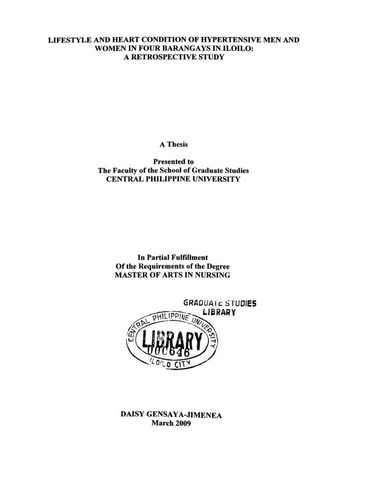| dc.description.abstract | This study was conducted if there is a significant association between personal characteristics, cigarette smoking, alcohol drinking and exercise practices of men and women and their heart condition. This is a retrospective-relational study where it begins with dependent variable and looks forward for cause or influence, and further investigation of relationships between factors or variables. In this study, secondary data were gathered from the medical mission and follow-up medical consultations conducted by People Helping People Paramedical and Nursing Service Ministry, Inc. (PHP PNSMI) on the designated medical clinics in Jaro and Poblacion Oton, Iloilo. The data were computered-processed using SPSS software.
Result of the study showed that there was no significant association between personal characteristics such as age, civil status, educational attainment and work status; and cigarette smoking. This means that the above personal characteristics of the respondents were not associated with cigarette smoking, while gender and respondents with family history of heart disease were significantly associated with cigarette smoking habit. This means smoking is gender differentiated, males tend to smoke more than females; and the family history of heart disease may influence the persons smoking habit. Also, no significant association was found between personal characteristics such as age, civil status, educational attainment, and family history of heart disease; and alcohol drinking while gender and work status were significantly associated with alcohol drinking habit of the respondents. This means that more males have the tendency to drink alcohol than females. There was also no significant association between personal characteristics such as age, gender, civil status, educational attainment, and work status; and exercise. This means that the above personal characteristics of the respondents were not associated with exercise. However, respondents who have no family history of heart disease was significantly associated with exercise. Lastly, no significant association was found between the lifestyle practices of men and women, and heart condition as indicated by their ECG. This means that lifestyle practice is independent of heart condition. Interestingly, there is an increase in the number of respondents with normal ECG tracings. Lifestyle practices of the men and women such as cigarette smoking, alcohol drinking, and exercise were not significantly associated with heart condition as indicated by ECG.
Conclusions
Based on the findings of the study, the following conclusions and generalization were derived.
1. Respondents were dominantly older adults, female, married, elementary and high school educated. They were employed nearing retirement stage and had family history of heart disease.
2. Although high majority of the respondents were practicing a healthy lifestyle, (nonsmokers and non-alcohol drinkers), there were some who did not spend time for exercise.
3. More than half of the respondents don’t have a normal heart condition, they were diagnosed with having dysrhythmia, ischemia, or left ventricular hypertrophy.
4. Only respondents’ gender and have family history of heart disease were significantly associated with lifestyle practices like cigarette smoking. It can be seen more in males.
5. Only respondents’ work status and gender were significantly associated with alcohol drinking as lifestyle practice. This can be seen in male respondents.
6. Respondents did not spend time to exercise, even though there were some who had a family history of heart disease.
7. Almost all of the respondents have normal heart condition regardless of age. However, single males, high school educated, working or not, and with no family history of heart disease do not have normal heart condition.
8. Respondents of all ages have almost equal percentage of having normal heart condition, more individuals were diagnosed of dysrhythmia, while the rest have either ischemia, left ventricular hypertrophy or a combination of the said heart condition.
9. More female respondents have normal heart condition than males. There were some males who were diagnosed with dysrhythmia, while left ventricular hypertrophy is common to females.
10. Respondents, either married or single, have almost equal proportion of having normal heart condition. However, more singles were diagnosed with dysrhythmia and left ventricular hypertrophy while more married respondents were having ischemia.
11. More college educated respondents have normal heart condition than those from elementary and high school levels. Almost all levels have heart condition but ischemia is prominent in elementary educated respondents.
12. Respondents who are working and not, have equal proportion of having normal heart condition and have the same proportion of having heart condition.
13. Respondents having normal heart condition were those who don’t have family history of heart disease, while those who have family history of heart disease have higher occurrence of heart condition.
14. Respondents, whether they smoke or not, have equal proportion of having heart condition. Smokers have normal heart condition than those who don’t smoke. This result is conflicting.
15. Non-alcohol drinkers have normal heart condition than alcohol drinkers. More heart conditions were diagnosed to alcohol drinkers.
16. Respondents who do not exercise have normal heart condition than those who exercise. It is sad to note that more heart conditions were diagnosed to those who exercise. | en_US |


